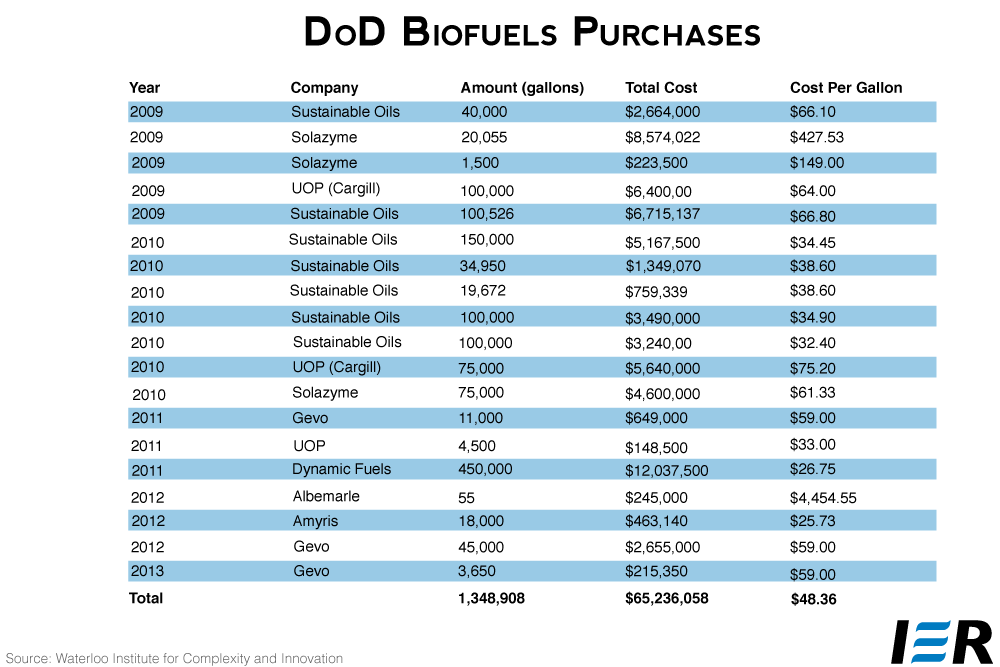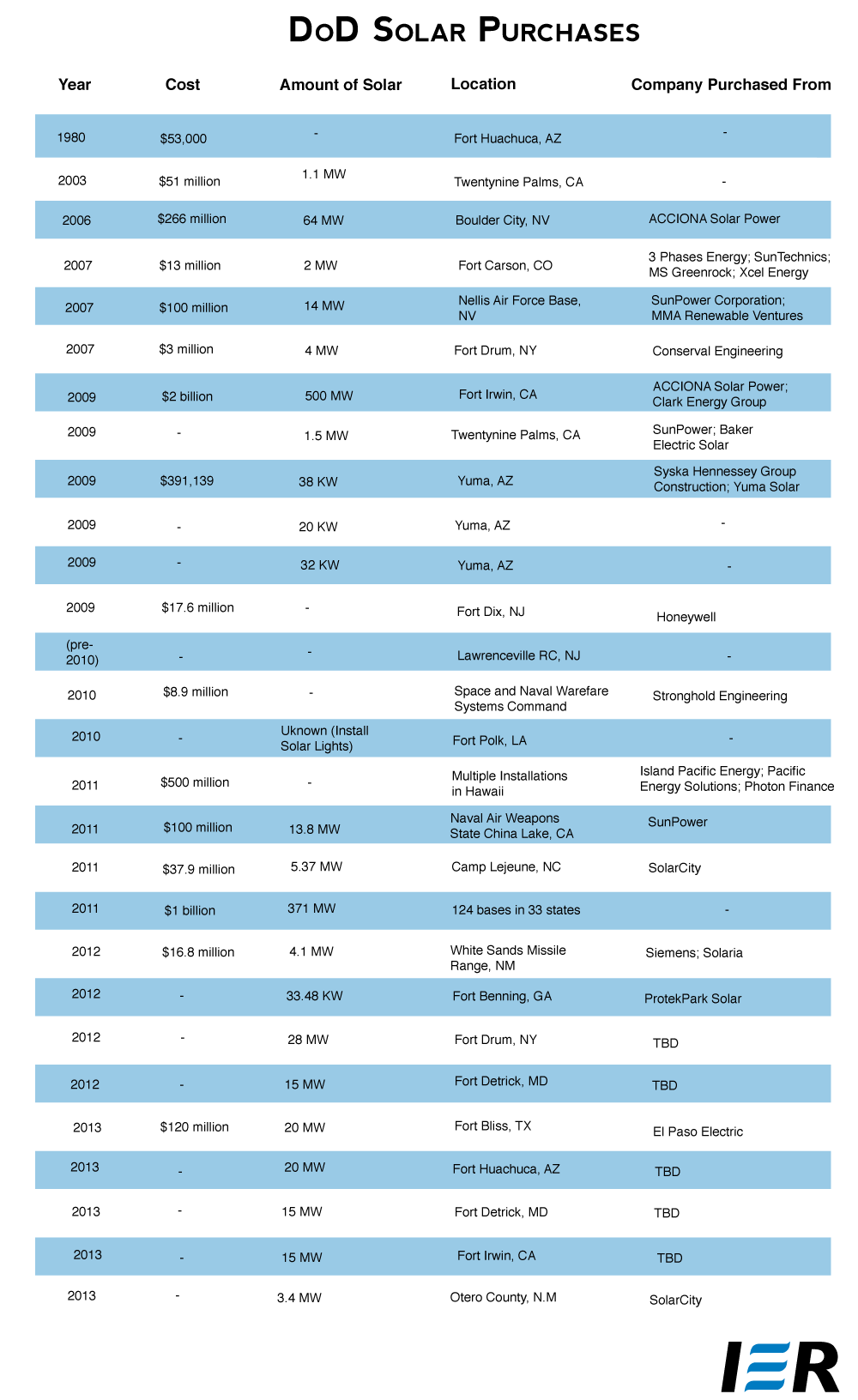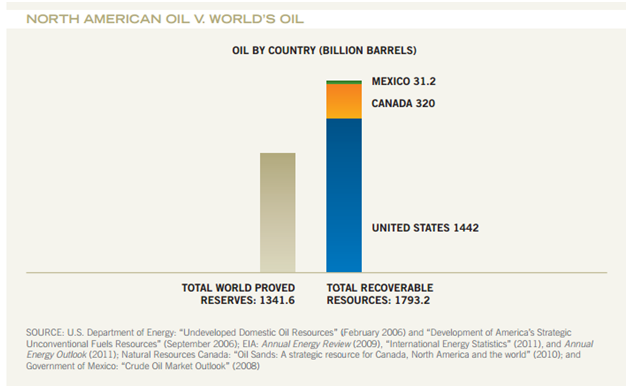The Department of Defense (DoD) is the largest energy consumer in the United States. To meet its energy needs, the Defense Logistics Agency (DLA) executes contracts to purchase fuel and electricity on behalf of the service branches. These contracts present opportunities for the federal government to provide de facto subsidies, should they choose to purchase more expensive sources of energy than is necessary. For the purposes of this report, subsidies are defined as disbursements by the federal government that have an identifiable federal budget impact and are specifically targeted at energy production. If the government pays more than the fair market value for a good or service, particularly in a closed-bidding process, this amounts to a subsidy.
The Institute for Energy Research’s (IER) Federal Energy Spending Tracker is a comprehensive database of the most significant forms of federal subsidies for energy producers. The database includes grants, loans and loan guarantees, and tax subsidies from FY 2009 to 2012. IER’s database, however, does not include contracts since the public data do not provide clear examples of cases in which the government paid more than fair market value for energy products.
This report serves as a starting point for evaluating government contracts for potential subsidies to energy producers. The report focuses exclusively on military biofuels and solar purchases, which, as purchases of products that are generally more expensive than readily available substitutes, are likely to contain subsidies. For many of these purchases, the rationale for buying energy above market value is to satisfy military and political goals and mandates for greater renewable utilization. In addition, another proxy for evaluating whether a contract includes a subsidy is to determine if a contract was either totally excluded from full and open competition or partially excluded. In the case of military biofuel and solar purchases, this information was not readily available for all contracts; as such, they are evaluated in this report based on whether the product may have been purchased above fair market value.
Executive Summary
Over the last decade, the U.S. military has dramatically expanded renewable energy purchases. The DLA has spent more than $2.2 billion on solar purchases since 2003 and more than $65.2 million in biofuels purchases since 2009. This activity began under the George W. Bush administration after passage of the Energy Policy Act of 2005 (EPAct 2005) and the Energy Independence and Security Act of 2007 (EISA 2007) and has accelerated rapidly under the Obama administration.
In many instances, the DLA purchases biofuels dramatically above fair market value. Military biofuels purchases since 2009 have cost an average of $48.36 per gallon, even though the Department of Defense (DoD) can execute bulk contracts of conventional fuels for about $3.24 per gallon. The largest purchase was 450,000 gallons in 2011 at a cost of $26.75 per gallon for fuel used in a Navy demonstration of the so-called “Great Green Fleet.” During this event, the Navy used a mix of biofuel and petroleum to fuel a guided missile destroyer and two destroyers, as well as some aircraft. The worst deal for taxpayers on a per gallon basis was a 2012 purchase of 55 gallons of biofuels for $245,000—a cost of $4,454 per gallon. These purchases are clearly subsidies, as they amount to the federal government purchasing products above market value when cost-competitive alternatives exist. This serves to prop up the company supplying the subsidized product because in the absence of DOD’s purchases, no market would exist.
Compared to biofuels, however, it is more difficult to determine whether individual solar purchases constitute a subsidy, since it is less clear whether less costly alternatives were feasible in each specific case. However, solar is one of the most expensive sources of electricity generation and it is far more expensive than grid power in the United States. This means the vast majority of solar purchases made for installations connected to the grid are likely subsidies.
DoD Biofuels Purchases
The military has been purchasing biofuels since the mid-2000s and photovoltaic solar power since at least the 1980s. Both sets of purchases have been part of an energy diversification strategy that accelerated first during the George W. Bush administration and even more under the Obama administration. The military’s stated reasons for moving toward alternative fuel sources include climate change, dependence on foreign oil, and reliance on the civilian electrical grid. DoD is also shifting to alternative energy to comply with the National Defense Authorization Act of 2007, which requires the military to obtain 25 percent of its electricity from renewable sources by 2025.
Since 2009, the DLA has made at least 19 biofuels purchases totaling more than $65 million. As the next chart shows, on average, biofuels have cost taxpayers between $30 and $60 per gallon, compared to about $3.24 per gallon for conventional fuels on a bulk contract.
The above biofuels purchases have mostly been limited to a few companies. The largest include Sustainable Oils, Solazyme, UOP (Cargill), and Gevo. As the chart shows, Gevo has secured at least three biofuels agreements with DoD totaling more than $3.5 million, the most recent of which was announced by Gevo in its latest quarterly report. For each deal, DoD agreed to pay exactly $59 per gallon, significantly above market value.
In addition to direct biofuels purchases, the DoD is also trying to create “complete domestic value chains capable of producing drop-in replacement biofuels.” The Advanced Drop-In Biofuels Production Project provides an estimated $210 million in contract authority for the DoD to develop biofuels projects with the goal of developing an “Integrated Biofuels Production Enterprise” with at least 10 million gallons of annual production capacity.
To this end, the DoD announced in May its first contracts under the project totaling $16 million to Emerald Biofuels, Natures BioReserve, and Fulcrum Biofuels. The companies will develop plans for up to 150 million gallon biorefineries. The military expects the biofuels to be produced by 2016 at a cost of less than $4 per gallon. Currently, the DoD pays an average of $48.36 per gallon for biofuels.
The Department of Energy (DOE) is also in the business of funding biorefineries for military applications. Most recently, DOE announced that four biorefinery projects would receive up to $18 million to develop pilot-scale “drop-in” biofuels for jet fuel and ship diesel. One of the companies, Frontline Bioenergy LLCM, was awarded up to $4.2 million to build a refinery capable of producing just 1 barrel per day of fuels derived from woody biomass, municipal solid waste, and refuse. The following chart describes the projects:
In many cases, the military’s green energy purchases constitute subsidies for alternative energy. According to the Department of Energy (DOE), algal biofuels in particular are “not economical to produce using the technology available today.” Despite the exorbitant cost, the military continues to prop up industries that, in the case of algal biofuels, would essentially not exist without federal support.
In addition to the uneconomical cost of biofuels, America’s abundant supplies of domestic oil resources obviate the need for biofuels. North America’s 1.79 trillion barrels of total recoverable oil reserves are enough to fuel every passenger car in the United States for 430 years, almost twice as much as the combined proved reserves of all OPEC nations, and more than six times the proved reserves of Saudi Arabia. Furthermore, the federal government owns the National Petroleum Reserve—Alaska (NPR-A), formerly known as Naval Petroleum Reserve No. 4 when it was established in 1923 as an emergency oil supply for the U.S. Navy. According to the U.S. Geological Survey, NPR-A contains 896 million barrels of conventional, undiscovered oil. It makes little sense for the military to purchase expensive, scarce biofuels when the U.S. has vast supplies of affordable, conventional fuels.
Like grants and loans, green energy purchases are just another way for the federal government to subsidize expensive products that consumers do not want when conventional fuels are cheap and abundant. Instead of allowing the military to focus on its core mission, the federal government insists on using the military as a guinea pig for testing exotic biofuels.
DoD Solar Purchases
Military photovoltaic solar purchases have skyrocketed over the last 30 years. One agreement in 1980, for example, totaled $53,000, compared to a $1 billion agreement struck in 2011. The Bush administration spearheaded many of the purchase agreements of the 2000s, but the pace and size of the agreements accelerated during the Obama years. In 2012, the Obama administration announced “one of the largest commitments to clean energy in history” with the goal of deploying 3 gigawatts of green energy, including solar, wind, biomass, and geothermal, on Army, Navy, and Air Force installations by 2025.
At the time of the announcement, the Obama administration claimed that “renewable energy is critical to making our bases more energy secure.” Yet there are no discernible safety benefits to using renewable energy such as solar over conventional sources of electrical generation. For example, power inverters for solar systems are designed to shut off automatically in the event of a grid failure. In addition, solar power only works when the sun is shining, making it less reliable than baseload power sources such as coal and natural gas, and necessitating the use of conventional backup sources.
As the next chart shows, the vast majority of the solar purchases have been for military bases in Western states, including California, Arizona, New Mexico, and Hawaii. The largest purchases, respectively, have been $2 billion for 500 MW of solar power in Fort Irwin, CA in 2009 and $1 billion for 371 MW in 124 bases across 33 states in 2011. The companies providing the solar power have mostly been disparate. The major players include SolarCity, ACCIONA, and SunPower. The purchases include photovoltaic solar arrays, microgrids, and occasional experiments with concentrated solar power (CSP).
In addition to these purchases, the Air Force plans to add 488 MW of capacity from renewable sources by 2018 as part of its Renewable Energy Game Plan. The EPA’s Green Power Partnership ranks the Air Force number one in DoD and number two in the federal government for its green energy purchases. According to the Air Force, the branch more than doubled its number of renewable energy projects in 2012.
For its part, the Army recently announced a pair of $7 billion renewable energy purchases. One is described as a “first of its kind” Indefinite Delivery Indefinite Quantity (IDIQ) Multiple Award Task Order Contract (MATOC). The initial announcement was for a geothermal award, with contracts for solar, wind, and biomass expected by the end of 2013. The other provides $7 billion in contract capacity for green energy purchases over three decades through purchase power agreements.
Overall, DoD plans to install 3 GW of renewable energy at military installations by 2025 from a combination of solar, wind, biomass, and geothermal. President Obama reiterated this commitment as recently as June 25 at a speech on climate change at Georgetown University. Other broad goals include adding 1 GW of green energy capacity on Navy installations by 2020, 1 GW for the Air Force by 2016, and 1 GW for the Army by 2025.
As is the case with biofuels, the DoD’s solar purchases confer subsidies for solar energy producers. Electricity derived from solar tends to be more expensive than baseload sources such as natural gas, coal, and nuclear. EIA estimates the levelized cost of photovoltaic solar plants at $144.3 per megawatthour (MWh), compared to $67.1 per MWh for conventional natural gas, $100.01 per MWh for conventional coal, and $108.4 per MWh for advanced nuclear. Since these installations are connected to the electrical grid, the military has the option of purchasing electricity from less expensive conventional sources. By purchasing expensive solar energy instead of affordable conventional energy, the federal government is allowing political preferences to trump sound economics.
The Navy’s “Great Green Fleet”
In 2011, the military made its biggest biofuel purchase when it spent $12 million on 450,000 gallons of biofuel for the Navy’s so-called “Great Green Fleet.” The biofuel was used for a demonstration during the 2012 Rim of the Pacific (RIMPAC) exercise, the world’s largest international maritime exercise. The demonstration showed that the 50-50 mixture of biofuel and petroleum could be used as a drop-in replacement for conventional fuel in an operational setting.
However, focusing exclusively on whether biofuels can serve as replacement fuel ignores the cost of purchasing expensive biofuels over conventional fuel. The biofuels used in the Great Green Fleet demonstration cost taxpayers more than $26 per gallon, when conventional fuel can be purchased for much less. If both biofuels and conventional fuels have comparable performance, then it makes economic sense for the military to purchase the fuel that is less expensive.
The Great Green Fleet, which the Navy plans to deploy in 2016, is one of five “aggressive energy goals” announced by Navy Secretary Ray Mabus in 2009. One of the stated goals of the program is to “improve our combat capability and to increase our energy security by addressing a significant military vulnerability: dependence on foreign oil.” Reducing dependence on foreign oil, specifically Middle Eastern oil, is a laudable goal. Fortunately, we do not need expensive biofuels to achieve this goal. As noted above, the United States, and North America as a whole, has vast energy resources. The U.S. supply of technically recoverable oil reserves is estimated at 1.44 trillion barrels. In total, North America has more than 1.79 trillion barrels of recoverable reserves.
Furthermore, the recent shale energy revolution, made possible by technological advancements in hydraulic fracturing and horizontal drilling, has led to the greatest domestic energy boom in American history. In oil shale alone, the U.S. has over 982 billion barrels of technically recoverable resources. The map below shows shale plays in the continental United States, many of which were inaccessible just a few years ago.
Those who doubt the abundance of domestic oil resources often note that while the U.S. has about 3 percent of the world’s oil reserves, the country consumes a quarter of the world’s oil. These misleading figures rely on proved reserves, which represent quantities of oil that are known to exist in places where development is already occurring at current economic prices. These figures do not, however, account for the massive quantities of oil that exist in areas where development is not permitted to take place or where new technology will add to the reserve base.
Proved reserves have been a historically unreliable indicator of America’s energy potential. In 1980, the U.S. contained about 30 billion barrels of proved reserves. Yet from 1980 through 2010, America produced over 77 billion barrels of oil. That means over the last 30 years, U.S. oil production exceeded proved reserve estimates by more than 150 percent. Total recoverable reserves, on the other hand, are significantly higher than U.S. proved reserve estimates. If these massive quantities of U.S. oil are made available to explore and produce, the current estimated reserves of 20 billion barrels would certainly increase, providing dramatically more domestic production for decades to come.
As the following chart shows, North American supplies of total recoverable oil resources dwarf the proved reserves of the rest of the world. Moreover, a recent analysis of global energy data finds that the U.S. led the world with the largest oil and natural gas production increases in 2012. Last year also saw the largest year-to-year gain in oil production in U.S. history. These figures demonstrate domestic energy abundance, not scarcity.
In contrast to America’s vast oil resources, the U.S. supply of biofuels pales in comparison. While the U.S. produced about 100 billion gallons of oil in 2012, the country produced just 13.3 billion gallons of ethanol, the largest source of biofuel, and a fuel with only two-thirds the energy content of an equivalent amount of oil. And unlike oil and gas, the biofuels industry is supported by a federal mandate that requires refiners to blend increasing amounts of ethanol into gasoline. Without this Renewable Fuel Standard (a form of subsidy in itself), the market for ethanol would likely shrink considerably.
Not only can America’s vast oil resources be produced domestically, but they are also cheap and abundant. In other words, conventional fuels represent a win-win for the military: energy that is both affordable and reduces America’s dependence on foreign oil. But the military is increasingly displacing affordable oil and natural gas in favor of exotic, unaffordable, and unproven biofuels. To ignore these basic economic facts in favor of propping up the biofuels industry constitutes a subsidy for biofuels and a waste of taxpayer funds.
Conclusion
Federal contracts are potential subsidies when the government purchases a product above fair market value, particularly in a closed-bidding process. Since data from USASpending.gov do not provide a clear picture of contracts for the purposes of identifying potential subsidies, IER does not include contracts data in the Federal Energy Spending Tracker. However, this report shows that the U.S. military has made numerous purchases of uneconomical biofuels and solar systems dramatically above market value when conventional sources provide cost-competitive alternatives. Such purchases should be treated as subsidies for the biofuels and solar industries just like grants, loans, and tax subsidies. At a time of increasing pressure on DOD budgets, questions are arising concerning the wisdom of spending more than is necessary for something so basic as energy for the military. As time goes on, IER will continue to highlight examples of government contracts that confer subsidies to energy producers and products.
IER Policy Associate Alex Fitzsimmons authored this post.








